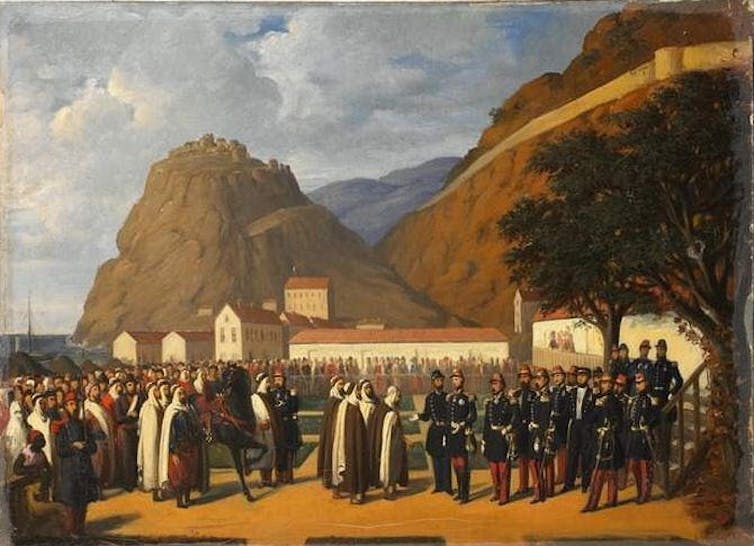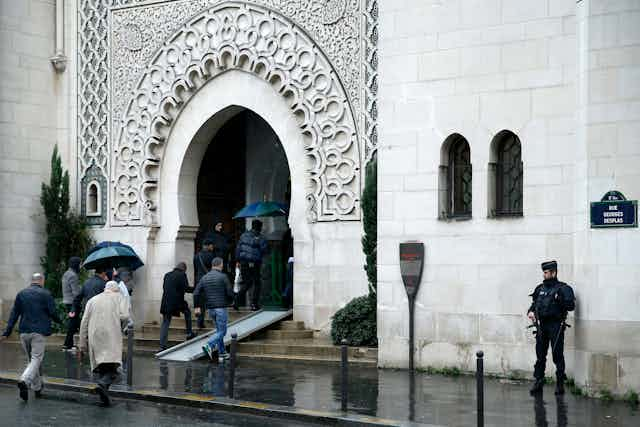The idea of a multicultural France is under threat following the November 13 attacks on Paris. Voices from the right to the left of the political spectrum have called for stricter immigration controls and a renewal of France’s longstanding tradition of “assimilation”.
But what exactly is this supposed tradition, and what is its historical and political context?
Assimilation and ‘race war’
In France, the issue of assimilation emerged in the 19th century. The question then wasn’t migrants, but of the place of Jews in French society. It was presented as a way to prevent a “race war” that anti-Semitic intellectuals – notably Edouard Drumont, author of Jewish France – threatened would break out. Assimilation was presented as a social pact: the ability to privately maintain one’s religion in exchange for full participation in the construction of the nation.
Such discussions are best understood within the context of the time – they took place during a drive to erase regional and linguistic differences in France through free schooling and compulsory military service. Assimilation was seen initially as a way to treat domestic “others” – Jews – and more broadly, to forge a collective identity out of the mosaic of French regions.
This took place during the colonial era, so the question arose: should the people in colonised countries such as Algeria be included in the policy of assimilation? Those who opposed extending rights to colonised people came up with the concept of “assimilability” to prevent this. They held that some indigenous populations had cultural and racial characteristics that made them unable to accept the universal social pact.
Political thinker Alexis de Tocqueville made a voyage in 1840 to study Algerian tribes. The mission’s findings still haunt today’s debate on integration. Muslim tribes, portrayed as deeply religious as well as polygamous, nomadic, and unwilling to work, were described as being the farthest from the national standard, and hence the least “assimilable”.
Under Napoleon III, the government implemented a “religious status” law: It allowed Muslims in Algeria – part of France at the time – to practice aspects of their religion that would have otherwise been illegal under French law (including the right to have several spouses), but which also deprived them of the right to vote and of eligibility for citizenship.
Nationality and citizenship were thus separated based on religion, effectively legalising this hierarchy: to be eligible for citizenship, immigrants were effectively required to renounce religion in the public sphere.

In the late 19th century, France began to bring in immigrants – mainly from neighbouring countries such as Belgium, Italy and Spain – to compensate for its declining population. The state adopted the jus soli (“right of soil”), which meant that children born in France, could become citizens, whether their parents were French-born or not.
Algeria and Tunisia also attracted a large number of immigrants in this time, mostly Spanish and Italian, threatening to make the French a minority there. To address this problem, an 1889 law opened the way for French citizenship for those migrants – but it favoured immigrants from Europe, giving them rights that weren’t extended to indigenous Muslims.
During the colonial period, there were three key components of assimilation policy: school, the army, and the right of soil. But it was a selective policy, racist and unequal, that built its notions on assimilability on the hierarchy of races and religions.
The class struggle
The next chapter begins after World War I. With economic growth strong, France needed labour. The question was entrusted to a consortium of entrepreneurs, the Société générale d’Immigration. Poland, newly independent in 1918, was a preferred source. For company owners, one of the key advantage of foreign workers was that they weren’t unionised. To protect them from any “contamination”, firms arranged with the Polish Catholic Church to provide priests for the workers. Their task, among others, was to prevent the new arrivals from joining unions.
The pattern was repeated for other European populations: Spanish, Italian or Portuguese churches were established where immigrant populations lived. The same process took place for Muslim populations, who were provided imams from their home countries. This is why organisations within the French Muslim Council (CFCM) are related to particular nations – Algeria, Morocco, Turkey, and so on.

To counteract companies’ efforts to control immigrants through their religion and ethnicity, unions organised evening French classes and assisted with citizenship. In this way, unions appear to serve as the melting pot of immigrant labour within the working class until the 1970s.
A new era began in 1974 when France closed its borders, significantly altering migration dynamics. Immigration for the purpose of work decreased while more migrants sought to bring their families. This definitive settling (and the subsequent arrival of “second generation” immigrants) occurs within a context of de-industrialisation and the decline of unions.
Under the new French immigration policy, helping immigrants preserve their cultural and religious identities served a key objective: it encouraged the return home. The state provided support to Algerian, Tunisian and Moroccan benevolent societies that served as social spaces, provided Arabic classes and provide religious services. Teachers and imams were effectively agents of immigrants’ states of origin.
The term “assimilation” is then replaced by that of “integration”. But the policy remained paradoxical, combining access to greater rights with structures that eased the immigrants’ return to home countries.
Repression makes a comeback
As this brief history indicates, assimilation à la française was from the start a selective ideology. Initially implemented for domestic reasons, it was accompanied by a range of policies and strategies that sought to maintain the ethnicity of populations thought to be “unassimilable”. This has been used for a range of purposes: keeping non-French people at arm’s length, managing labour supply, encouraging a return to home countries. The doctrine wasn’t homogeneous, but a dialectic whose historical effects are still visible today.
In the current political landscape, former president and now-candidate Nicolas Sarkozy and his party, Les Républicains, emphasise the term “assimilation”, within a context of a rigorous redefinition of French secularism (“laïcité”) and the rise of religious fundamentalism. While the primary target is the visibility of Islam in the public sphere, the term now emphasizes the responsability of immigrants (and Muslims in particular) to demonstrate their attachment to French values. In 2011 citizenship tests were introduced to obtain French nationality at the same time that integration and anti-discrimination policies were dismantled. In this way, the current situation echoes that of more than a century ago.
But rather than concerning new arrivals, in France today the real question is the place of the descendants of immigrants. The challenge is to define a social compact similar to that established for French Jews in the 19th century: the right to be left in peace in exchange for the ability to join in the building of the nation.
This negotiation continues. On one hand, the dynamics of integration have enabled the development of a middle-class Muslim culture that has won this right. They are teachers, journalists, doctors, lawyers, business executives who are part of daily life in France. But this link is broken for the working class, a consequence not unrelated to the decline of the unions. The 2005 riots can be read as a failed step in the negotiation process.
Ten years later, the turn toward extremism of a fringe of France’s Muslim population is part of a broader rightward shift of the working classes. Nearly 170 years after de Tocqueville’s mission, the terms of the negotiation are the same: are Muslism members of the working class “assimilable”?
The current debate in France over the term “assimilation” is a mark of this tension. What the answer will be is playing out partly in the mosques, which are gradually losing their connections to the home countries as new immigrants and converts arrive. Together, these two groups will redefine what it is to be Muslim in French society, a definition, one can hope, that will escape from the supposed tradition of “assimilation”.
Translated from the French by Leighton Walter Kille.


